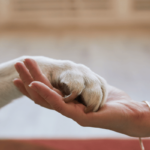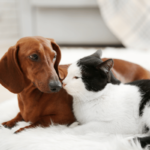Creating an enriched environment for pets with mobility issues ensures they stay entertained and happy. Here are practical tips to help you.
Adapting the Home Environment

For pets with mobility issues, making simple home modifications can greatly enhance their quality of life. Consider adding ramps to help them navigate stairs or furniture. Ensure their favorite resting spots are easily accessible, and avoid slippery floors by using rugs or mats. These changes not only help them move around safely but also give them confidence to explore their surroundings.
Providing a variety of textures and scents can stimulate your pet’s senses and make their environment more interesting. Use different types of bedding materials, like soft blankets or padded mats, to provide comfort. Introducing new scents through toys or treats can also engage their curiosity. Additionally, placing their food and water dishes at an accessible height can prevent unnecessary strain on their joints.
Interactive toys are excellent for encouraging physical and mental activity. Toys that dispense treats or have different textures can keep pets entertained and engaged. For dogs, consider using puzzle feeders or chew toys. For cats, provide scratching posts and toys that mimic prey behavior. These activities promote natural behaviors and can be adjusted to suit their mobility levels.
Outdoor Activities and Exercises
Taking your pet outside can offer new experiences and stimulate their senses. Ensure your yard is safe and accessible by removing obstacles and providing shaded areas for rest. If your pet enjoys short walks, choose routes with smooth surfaces and minimal inclines. Allow them to explore at their own pace and provide plenty of breaks.
Hydrotherapy can be beneficial for pets with mobility issues, as it provides low-impact exercise that supports their joints. Look for facilities that offer pet hydrotherapy sessions or create a small, shallow pool at home for supervised water play. Swimming can improve their muscle strength and flexibility while also being enjoyable.
Regular, gentle exercises tailored to your pet’s abilities can maintain their physical health. Consult with a veterinarian or a pet physiotherapist to design a suitable exercise plan. Simple activities like gentle stretches or guided movement exercises can enhance their mobility and overall well-being. Remember to monitor their comfort and adjust the exercises as needed.
Mental Stimulation and Engagement

Mental stimulation is crucial for pets with mobility issues, as it keeps their minds active and prevents boredom. Provide interactive toys and puzzles that challenge their problem-solving skills. Rotating toys regularly can maintain their interest and excitement. Food-dispensing toys are particularly effective, as they combine mental engagement with the reward of a treat.
Engage in daily training sessions to teach new commands or tricks. Even pets with limited mobility can learn new skills that stimulate their minds. Use positive reinforcement techniques and keep the sessions short and fun. Training not only strengthens the bond between you and your pet but also provides them with a sense of accomplishment.
Create a comfortable and cozy space where your pet can relax and observe their surroundings. Position their bed near a window or in a part of the house where they can see and hear daily activities. This helps them feel involved and reduces feelings of isolation. Ensure their resting area is padded and easily accessible to prevent discomfort.
Incorporating Enrichment in Daily Routines
Incorporating enrichment activities into your pet’s daily routine ensures they remain active and engaged. Establish a consistent schedule for playtime, training, and relaxation. This predictability can reduce anxiety and give your pet something to look forward to each day. Make sure to vary the activities to keep them interesting and stimulating.
Involve the entire family in your pet’s enrichment. Children can help with playtime, while adults can manage training and exercise sessions. This creates a supportive environment where your pet receives attention and care from all family members. It also strengthens the bond between your pet and each family member.
Monitor your pet’s responses to different activities and adjust accordingly. Pay attention to their preferences and comfort levels. If they show signs of discomfort or disinterest, modify the activities to better suit their needs. Regularly assess their physical and mental health and consult with a veterinarian to ensure their enrichment plan is effective and appropriate.
Ensuring Fun for Pets with Mobility Issues

In conclusion, enriching an environment for pets with mobility issues involves thoughtful modifications and engaging activities. By adapting the home environment and providing suitable outdoor experiences, pets can enjoy a fulfilling life. Incorporating mental stimulation and consistent enrichment routines ensures they stay happy and healthy. Remember, every pet is unique, so tailor the enrichment activities to their specific needs. For more tips on pet care, visit DW Focus.
Encouraging interactive play and using varied textures and scents can keep pets entertained and stimulated. Regular exercises tailored to their abilities help maintain their physical health. Creating a supportive environment where they feel involved and loved is crucial. Share your experiences and tips in the comments below or explore more pet care articles on our website.
Hydrotherapy and gentle exercises offer low-impact ways to enhance mobility. Engaging toys and puzzles challenge their minds, preventing boredom. Involving the whole family in your pet’s care routine strengthens bonds and provides comprehensive support. Visit DW Focus for additional resources and join our community of pet lovers today.

Join Marjorie Pearson at dwfocus.com, your guide in the pet parenting world. As an experienced animal behaviorist, Marjorie offers heartfelt advice for pet owners. Her expertise spans from nurturing kittens to understanding dogs’ playful antics. She’s passionate about enhancing the bond between pets and their humans through understanding and empathy. Discover Marjorie’s practical training tips and insights on dwfocus.com, enriching your journey as a pet owner. #4PawsAndOwners #MarjorieEarsonPetWhisperer #dwfocus







